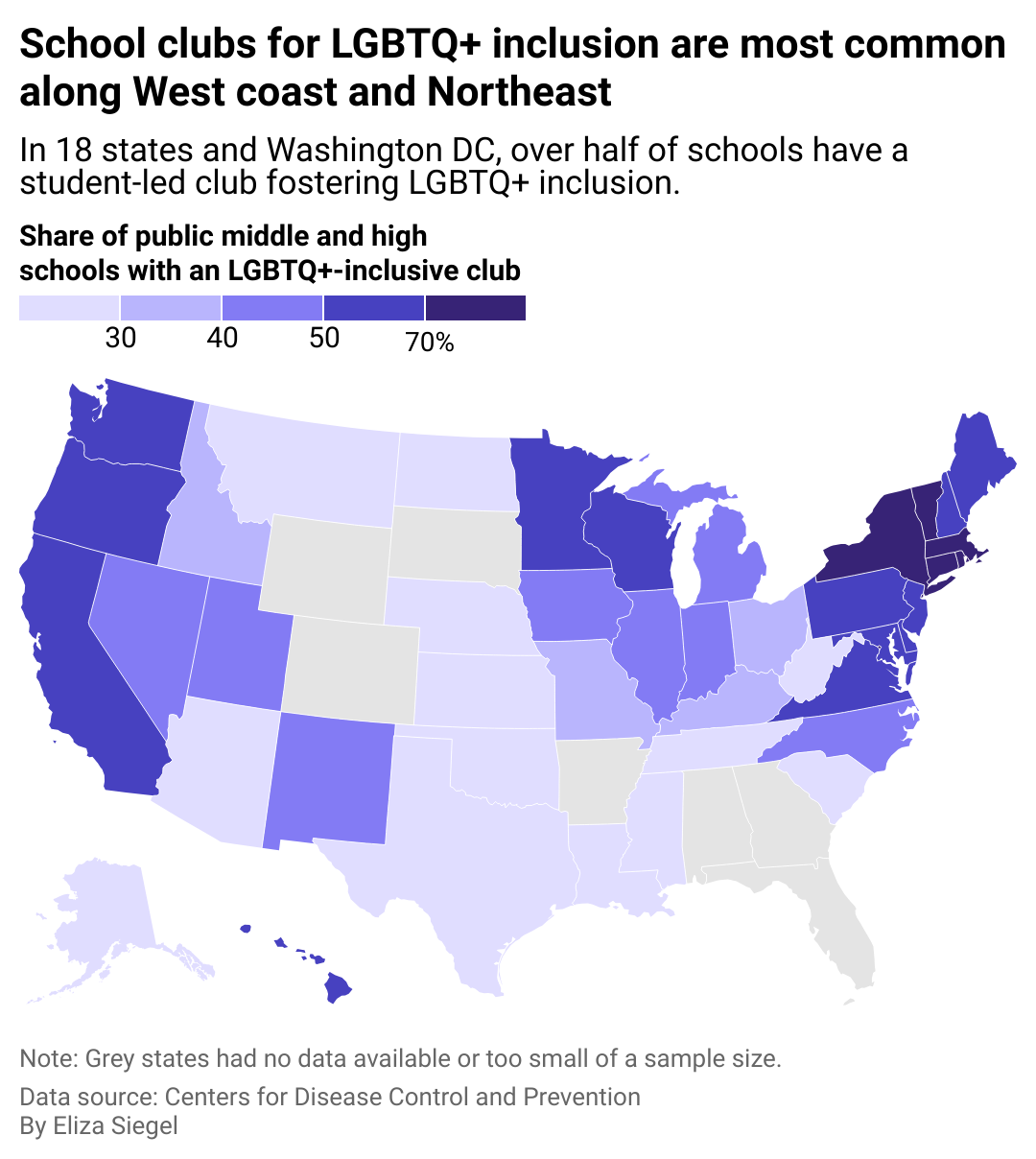Student-led clubs fostering LGBTQ+ inclusivity do a world of good, data says. These states have the most—and least.
Prathankarnpap // Shutterstock
Student-led clubs fostering LGBTQ+ inclusivity do a world of good, data says. These states have the most—and least.
Two students working on ceramics.
“I decided to join my school’s GSA for support, for community,” Esmée Silverman, co-founder of the nonprofit Queer Youth Assemble, told EdWeek in 2023. “I undoubtedly made a decision that shaped my entire life by going to that group. They gave me hope. It gave me solidarity, gave me confidence and made me feel like I had other people I could talk to, relate to.”
“Am I going to survive this next day? Am I going to ever feel this weight off of my chest? Am I gonna get kicked out of my house because my family doesn’t accept me? Am I going to be ostracized and bullied because students don’t understand anything about being trans?” These were the kinds of questions and weighty debates running through their mind at the time.
Silverman, who came from a Massachusetts high school, is one among the many whose lives have forever been changed by the presence of GSAs, or genders and sexualities alliances.
GSAs are typically school-based clubs where everyone is welcome, regardless of gender identity or sexual orientation. These organizations fulfill various functions for youth. They provide a safe space where students can be and express themselves, fostering a sense of community for LGBTQ+ youth and their allies through movie nights, field trips, or even pride parades. They may also involve activism like working to educate others or changing school rules and policies.
Today, at least 4,300 student-led clubs exist nationwide and are important in the U.S. education system. To better understand these connections, Stacker analyzed newly released data from the Centers for Disease Control and Prevention and combed through the history of LGBTQ+-allied school clubs to find out which states have the most and least student-led clubs to foster LGBTQ+ inclusion and what role they play in schools today.
You may also like: These 20 cities have seen the highest recent population growth anywhere in the US
![]()
Alex Brylov // Shutterstock
A landscape of wins and losses in LGBTQ+ rights
Group of students chatting around a wood table.
According to the American Civil Liberties Union, 2023 was a record-breaking year for the number of anti-LGBTQ+ bills introduced across the U.S., and 2024 is set to continue that trend. As of June 2024, the ACLU is tracking 516 anti-LGBTQ+ bills, 2 in 5 of which target the rights and privileges of LGBTQ+ youth within U.S. public schools. While most of these bills do not become law, some do, and most states have a policy landscape that negatively impacts the lives of LGBTQ+ people, according to the Movement Advancement Project.
“It’s really underestimated the impact of going from a president like Barack Obama—who openly supported gay marriage [and] who openly supported trans youth—to Donald Trump, a president, who not only seemed to relish in the opportunity to strip away as many rights and protections as possible,” Silverman said.
Reports emerging from some of these states highlight the changing landscape around anti-LGBTQ+ harassment, from an increase in anti-LGBTQ+ remarks in a public school in Texas to the Oklahoma state superintendent’s anti-LGBTQ+ statement following the death of 16-year-old Nex Benedict.
Despite the bleak outlook, there have been victories worth celebrating. In 2023, 238 LGBTQ+ candidates won their elections, according to the LGBTQ+ Victory Fund. LGBTQ+ performers have also recently won recognition at marquee awards events, such as the Tony Awards and the Grammys. Even more promising, a study by NORC at the University of Chicago found that the rest of the country has largely caught up to the progressive stance and support for LGBTQ+ rights of residents of California, which continues to have the largest LGBTQ+ population, according to Williams Institute data.
Such stories illustrate both the resilience of LGBTQ+ youth and their allies despite inhospitable environments, as well as the challenges they face as the U.S. education system becomes increasingly politicized around gender and sexuality.
Queer-allied school groups have historically played and continue to play a critically important role in the fight for greater LGBTQ+ visibility and support within the U.S. public school system. The most common term for these groups is gay-straight alliances or genders and sexualities alliances. While GSAs started to become truly widespread in the late 1980s, perhaps the first GSA to form in a public school was the Gay International Youth Society at George Washington High School in New York City in 1972.
The Gay International Youth Society was situated in a diverse community, with many Black, Puerto Rican, Cuban, Mexican, and Dominican families in the surrounding neighborhood. It was also part of an era of revolutionary gay liberation movements that began with the Stonewall uprising in 1969. In this context, GSAs and similar school clubs served to increase LGBTQ+ visibility while creating safe spaces for LGBTQ+ youth within existing institutions.

Eliza Siegel
Amid greater challenges is an increasing need for inclusivity in schools
Public middle and high school student-led clubs for LGBTQ+ inclusion are most common along the West Coast and in the Northeast and least common in the South and in the Northern mountain states.
GSAs have a long history of positively impacting the lives and well-being of LGBTQ+ youth in the public school system. Study after peer-reviewed study has demonstrated the many facets of this relationship, including fewer suicide attempts among LGBTQ+ youth who attend schools with active GSAs, lower rates of depression and anxiety, lower truancy, greater agency, and better overall well-being, to name a few.
This is also reflected in students’ actual experiences. “When I first joined, I was very anxious, but then these gremlins, they were always nice to me,” Cass Robin, a student at Fossil Ridge High School in Fort Worth, told Texas Monthly. Having people come up to me like, ‘Hey, let’s be friends,’ brings me a lot of joy because I can’t do that myself.”
It’s this kind of support that becomes even more crucial as school environments turn more hostile. Robin also detailed how they were able to wear shirts that proclaimed, “I’m gay,” in previous years; now, just having a flag feels unsafe in a state that had one of the lowest proportions of these clubs at 29.5%—the 12th least in the country among states with data.
According to The Trevor Project’s 2023 U.S. National Survey on the Mental Health of LGBTQ Young People, more than 8 in 10 of LGBTQ+ young people surveyed indicated “support/acceptance” as one of the most important topics for “people in their lives to know more about.” Additionally, respondents indicated that affirming spaces in school was second only to access to affirming spaces online in terms of important avenues for support.
Despite these clear benefits, LGBTQ+ youth report a lack of such resources in their schools. Only 48.3% of schools nationwide have a student-led club that fosters an accepting school environment. The 2021 National School Climate Survey from GLSEN, an organization that champions LGBTQ+ issues in education, found that only about a third of LGBTQ+ students said their school had an active GSA, and 3 in 25 reported being prevented from forming or promoting a GSA. The lack of these potentially life-saving resources nationally speaks to the politicization of the school system, with state legislatures playing a leading role in depriving school districts of the means to support LGBTQ+ students or paving the way for them to implement harmful policies. While not every effort to curb LGBTQ+ rights becomes successful, they can still weigh on a student’s mind and negatively impact their mental health, notes research scientist Dr. Jonah DeChants of The Trevor Project.
Indeed, when comparing states with lower proportions of GSAs versus those with higher proportions, the impact that such politicization and resource deprivation have on students is stark. Again, according to GLSEN’s 2021 survey, LGBTQ+ students in schools with GSAs were less likely to experience homophobic remarks, less likely to feel unsafe, were more likely to report that school staff intervened in anti-LGBTQ+ harassment, felt more connected to their communities, and performed better academically.
These trends were particularly evident in states with the lowest and highest proportions of GSAs. In Oklahoma, where only 17.4% of public schools had LGBTQ+-inclusive clubs, 70% of LGBTQ+ students experienced verbal harassment about sexual orientation in schools, 28% experienced physical harassment, and 14% experienced physical assault. Oklahoma had the second-least proportion of GSAs among the states and territories that provided data in the CDC report.
The largest proportion of clubs that foster LGBTQ+ inclusion is in Massachusetts, with 81.9% of schools with clubs. In that state, these negative experiences were markedly reduced to 44%, 12%, and 4%, respectively. Research using respondents from the state also found that GSA clubs reduce depression not only in LGBTQ+ youth but also school-wide.
Similarly, in Mississippi, which, at 13.1%, had the country’s lowest proportion of clubs among public schools, 44% of students reported being prevented from using their chosen name or gendered pronouns in school, 43% were prevented from using a gendered-aligned bathroom, and 38% from expressing affection publicly in school. In contrast, New York boasts the second-highest proportion of student-led clubs that fostered inclusion at 8 in 10 schools with such groups and reported 22%, 21%, and 19% of those incidents happening only about half the time, respectively.
These disparities represent meaningful examples of how profoundly the overall ecosystem of LGBTQ+ support directly impacts the lives, educational outcomes, and well-being of students. From that starting point, teachers and students can build additional structures together to fill in remaining gaps, like finding ways to support trans and nonbinary youth, who disproportionately face mental health challenges in school, and LGBTQ+ students of color, for whom GSAs result in fewer benefits than non-Hispanic or Latino white students.
Story editing by Carren Jao. Copy editing by Paris Close. Photo selection by Clarese Moller.

